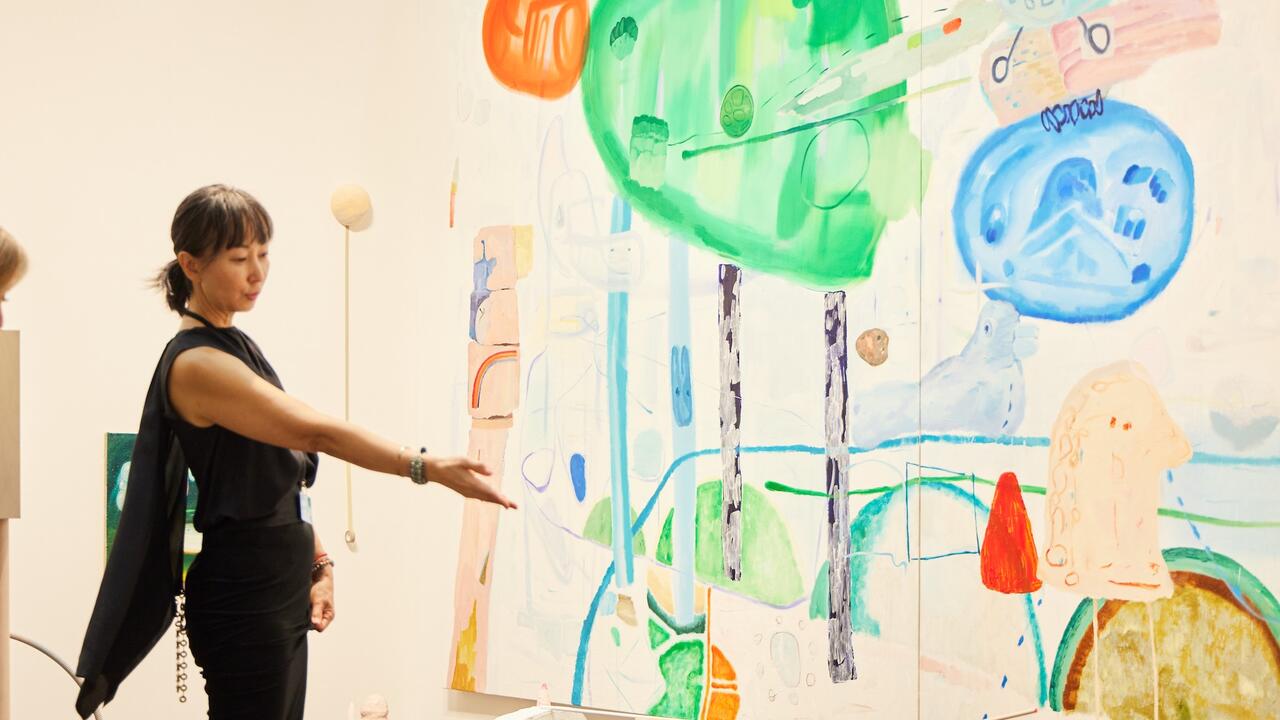El Hadji Sy
Weltkulturen Museum Frankfurt am Main
Weltkulturen Museum Frankfurt am Main

In the 1970s, long before the ‘global turn’ in contemporary art – the end of a Western-only art historical canon – Frankfurt’s Museum of Ethnology began collecting contemporary African art. In 2010 the new director of this institution, now the Museum of World Cultures, Clémentine Deliss announced that the ethnographic collection would be shown in dialogue with contemporary art as a way of exploring the legitimacy of an ethnological museum. Since then she has invited a number of artists including Antje Majewski, Otobong Nkanga and Luke Willis Thomson to work with the ethnographic collection as ‘field researchers’. But this exhibition curated by Deliss, Yvette Mutumba, Philippe Pirotte and the artist El Hadji Sy under the title El Hadji Sy: Painting, Performance, Politics was the first to focus attention on the museum’s own art collection.
One of Senegal’s most prominent artists, Sy combines painting with political activism and a curatorial practice. In the mid-1980s, he worked with the German linguist Friedrich Axt to assemble a collection of contemporary Senegalese art for the museum. This material featured in the retrospective but was shown as part of an archive that was presented separately to the artist’s own work, accompanied by extensive documentation of the artist’s practice. The exhibition concentrated on Sy’s painting since the 1970s. Shown were works collected by Axt himself, now on loan to the museum, and more recent works, some made in the museum’s own ‘laboratory’.
Sy paints not only on canvases, but also on flags, screens, kites, transport crates and jute sacks. His intensely colourful, gestural abstractions invite the viewer to touch, move and use them, lending the works a performative dimension. Some include organic forms and the outlines of figures – as in Les Piroguiers (The Canoeists, 2011), several canvas panels forming a makeshift vessel alluding to refugee tragedies – while other canvases bear footprints derived from choreographed stamping by the artist. Only a few of these pieces have survived however, and one of the earliest, Untitled (1978), is included in the show. With these works, Sy was responding directly to the demands of the cultural ideology of the time. During and after the presidency of Léopold Sédar Senghor (1960–80), cultural policy in Senegal privileged an aesthetic of Négritude and a post-colonial flourishing of African culture. Rejecting the picture sequences and tapestries that were being commissioned by the state from local artists, Sy turned instead to performative types of painting that became part of his social activism. For example, the stage objects and costumes he designed for the performances of the interdisciplinary artists’ collective Laboratoire Agit’Art, which he co-founded, were based on expressive albeit choreographed painting movements.

In this show, Sy supplemented his works with an arrangement of chairs, baskets, ladders and other objects from the museum’s collection from countries including Papua New Guinea, Mali and Ethiopia which displayed both formal and metaphorical correspondences. Four wooden stools, for example, stood on a floor painting structured around a well with the outlines of four heads (Le Puits, The Well, 2014). On the opposite wall hung a circular portrait of the former Senegalese president Abdoulaye Wade (Portrait du Président, 2012). Although this arrangement (like some others in the show) had a markedly political tone, what was key was the reconnecting of ethnographic exhibits with their use value. With its complex linking of ‘art’ and ‘ethnographic object’, the installation ultimately questioned the status of both as well as showing the role of the museum and its various departments in such attributions.
This exhibition displayed a complexity usually lacking in traditional art museums on account of their embeddedness in Western artistic ideologies. One need only think of last year’s major exhibition at Frankfurt’s Museum für Moderne Kunst, The Divine Comedy, for which curator Simon Njami invited 50 artists ‘with African roots’ (as the press release put it). Although Njami’s reference to Dante’s work aimed for a universal approach, the ‘African’ label had an essentializing effect: artistic positions that had little to do with one another were lumped together and insufficient differentiated. By contrast, this show succeeded because it presented an individual artistic position on its own terms, in its contradictions and in its historical context. The performative element referred to in the title featured only indirectly, and the large-scale installations that Sy also makes only appeared in the catalogue, but the decision to devote so much space to painting underlined its transformative importance for the artist. Finally, the inclusion of ethnographic objects focused Sy’s position further still by opening this transformative potential up to renewed discussion. The question of whether the show would have been better suited to an art museum is an inevitable one. But more important is the question of what art institutions can learn from this ethnological museum.
Translated by Nicholas Grindell
















